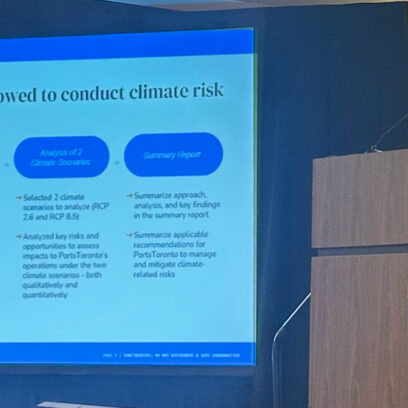Permanence Considerations When Buying Carbon Credits


🌍 Carbon markets can feel overwhelming—fragmented data, limited transparency, and conflicting advice make it hard to know where to start. In this webinar, our experts give a clear, practical introduction to the VCM.
Defining permanence, including how it’s measured, and how to balance permanence with other considerations and co-benefits when buying carbon credits.
Permanence is one of the most critical factors to consider when purchasing carbon credits. While other considerations (such as geography, vintage, additionality, and co-benefits) are also important, the permanence of a carbon offset project ensures that the carbon sequestered will have a long-lasting impact on reducing greenhouse gas (GHG) emissions. In this post, we will dive into the importance of permanence when buying carbon credits, including what permanence means, how to assess a project’s permanence, and why permanence is a crucial factor to consider in order to make informed decisions when investing in carbon offset projects. By the end of this article, you will have a comprehensive understanding of the role that permanence plays in carbon credit transactions, and you will be better equipped to buy carbon credits for your organization.
What Is Permanence?
In the context of carbon offset projects, “permanence” specifically refers to the amount of time that carbon will remain sequestered rather than being released back into the atmosphere through natural processes or human activities. The benchmark for permanence is generally considered 100 years, but some protocols and registries may require a longer timeframe, such as 1,000 years, to ensure that the carbon offset is truly permanent.
For instance, afforestation and reforestation are often seen as permanent solutions because the trees sequester carbon for several decades and can last centuries. In comparison, some carbon capture and storage (CCS) technologies may be less permanent as they require ongoing maintenance and monitoring to ensure the captured carbon remains sequestered. On the other hand, improved forest management methods are more permanent than CCS but less permanent than afforestation and reforestation.

Ready to Talk About Your Sustainability Goals?
Get tailored sustainability solutions that meet your business’s unique needs. CarbonBetter delivers tomorrow’s climate solutions—today. Contact Pankaj Tanwar, Managing Director of Climate Services, to get started.
Not ready yet? Read our client stories to see what it’s like to work with us.
It’s important to consider that nature-based solutions can be susceptible to natural disturbances like fires and pests, and human activities like logging and development. Therefore, when evaluating the permanence of a carbon offset project, it is essential to consider the specific technology, protocol, and registry being used to ensure that the expectations for permanence are appropriate for the project at hand.
The Climate Action Reserve
The Climate Action Reserve (CAR) is a widely recognized North American carbon offset registry that has established strict standards for permanence in carbon offset projects. In particular, the program requires a 100-year permanence standard for forestry projects, which involve the planting and maintenance of trees to capture and store carbon. This standard is crucial, as trees can sequester carbon for extended periods but are also vulnerable to natural disasters such as wildfires and diseases that could release the stored carbon back into the atmosphere.
Furthermore, CAR demands a 500-year permanence standard for geologic sequestration projects. Geologic sequestration provides a more secure carbon storage solution, as it stores carbon in a stable geological formation instead of trees, which can be easily burned or harvested. Therefore, projects using this method must meet a higher permanence standard. However, there is still a risk of leakage or other hazards that could threaten the project’s permanence.
By establishing these stringent permanence standards, CAR ensures that the carbon offset projects it certifies are genuinely effective at reducing GHG emissions and mitigating the impacts of climate change. The strict permanence standards play an essential role in promoting the integrity of the carbon offset projects and providing greater confidence in their long-term carbon sequestration potential.
The Permanence of Various Methods
The following table provides a list of carbon offsetting methods with their respective permanence, including the length of time carbon is removed from the atmosphere, whether it is considered permanent or not, and potential problems associated with each method (It’s important to note that these are just some of the carbon offsetting methods currently being used, developed, and tested):
THE PERMANENCE AND POTENTIAL PROBLEMS OF DIFFERENT METHODS
| Method | Years Sequestered | Is it considered permanent? | Potential Problems |
| Blue carbon coastal wetland restoration | 1,000+ years | Yes | Sea level rise, coastal erosion, storm surges, pollution, habitat loss |
| Afforestation and reforestation | 100+ years | Yes | Forest fires, insect infestations, deforestation, logging, climate change |
| Soil carbon sequestration | 100+ years | Yes | Soil degradation, land-use changes, erosion, drought, floods |
| Biochar | 100+ years | Yes | Improper storage, decomposition, wildfire, soil erosion, unsustainable production |
| Carbon capture and storage (CCS) | 1,000+ years | Yes | Leaks, geological instability, cost-effectiveness, public acceptance, lack of regulation |
Skip the RFP—CarbonBetter can help
CarbonBetter Certified Offset Portfolios allow carbon buyers to participate in a variety of projects, geographies, and technologies in one simple transaction rather than navigating a lengthy and complex RFP process with multiple carbon market participants.
Learn More about CBCO 22-1Below is a summary of each method shown in the table:
Blue carbon coastal wetland restoration
Blue carbon coastal wetland restoration is the process of restoring and conserving ecosystems such as mangroves, tidal marshes, and seagrass meadows to capture and store carbon from the atmosphere, reducing the impact of climate change. These coastal ecosystems have a high capacity to store carbon, making them effective tools in fighting climate change. The stored carbon can remain in the ecosystem for thousands of years, making it a permanent solution.
Two great examples of blue carbon coastal wetland restoration projects are the restoration of tidal marshes in San Francisco Bay and the establishment of mangrove plantations in Indonesia. These initiatives have successfully demonstrated the effectiveness of blue carbon restoration in reducing GHG emissions and providing co-benefits such as improved water quality and wildlife habitat.
Blue carbon restoration can generate additionality, meaning it can provide more carbon sequestration than would have occurred naturally. In addition, it offers co-benefits such as enhanced biodiversity and supporting the local economy through sustainable fishing, aquaculture, and eco-tourism.
The scalability and permanence of blue carbon coastal wetland restoration, combined with its potential to create economic opportunities for coastal communities, make it a promising solution for mitigating climate change impacts in the future.
Afforestation and reforestation
Afforestation and reforestation are practices that involve planting trees in previously forested areas and replanting trees in deforested areas. These practices help to combat climate change by sequestering carbon from the atmosphere, and the stored carbon can remain for decades or even centuries.
The Chinese "Green Great Wall" project aims to plant 100 billion trees across 4,480 km by 2050 to reduce desertification and increase carbon sequestration, and the African Forest Landscape Restoration Initiative (ALRI) aims to restore 100 million hectares of degraded forest landscapes by 2030. These projects have demonstrated the permanence and scalability of afforestation and reforestation.
Afforestation and reforestation generate additionality by providing more carbon sequestration than would have occurred naturally. In addition, they can offer co-benefits such as improving air and water quality, providing habitat for wildlife, and supporting local communities.
The future outlook for afforestation and reforestation is positive, with continued efforts and innovation expected to improve their effectiveness. The potential for scalability makes these methods valuable tools in the fight against climate change, with multiple benefits that make them worth investing in.
Soil carbon sequestration
Soil carbon sequestration is the process of capturing atmospheric carbon dioxide (CO2) and storing it in the soil in the form of organic matter. This method is considered a long-term, yet reversible solution for mitigating climate change, as the carbon can remain in the soil for centuries, but may be released if land management practices change. The permanence of sequestered carbon depends on factors such as soil type, climate, and land management.
An example of a project utilizing soil carbon sequestration is the 4 per 1000 Initiative, which encourages the adoption of agricultural practices that enhance carbon storage in the soil. The initiative aims to increase soil organic carbon by 0.4% annually, helping to offset global GHG emissions.
Soil carbon sequestration offers additionality, as it goes beyond conventional agricultural practices to create a net reduction in atmospheric CO2. Co-benefits include improved soil health, increased water retention, and enhanced crop productivity. These benefits contribute to food security and climate resilience, particularly in vulnerable communities.
The scalability of soil carbon sequestration depends on the widespread adoption of sustainable land management practices, policy incentives, and financial support for farmers. As awareness of the benefits of soil carbon sequestration grows, it has the potential to become a vital part of global climate change mitigation strategies.
"Permanence is an important factor to consider when purchasing carbon credits, as it ensures that the carbon offsets purchased will have a long-term impact on reducing GHG emissions."
nicole sullivan, former Director of Climate Services at CarbonBetter
Biochar
Biochar is a stable, carbon-rich material produced by the pyrolysis of biomass, such as agricultural waste or forestry residues, under limited oxygen conditions. It is considered a long-term carbon storage solution, as the carbon in biochar can remain stable for centuries or even millennia. The permanence of biochar depends on its characteristics and application methods.
An example of a project utilizing biochar is the Cool Planet Energy Systems project, which focuses on producing biochar from agricultural waste and integrating it into soil management practices. This approach helps to reduce GHG emissions and improve soil quality.
Biochar projects can provide additionality by diverting biomass waste that would otherwise decompose or be burned, releasing CO2 and methane into the atmosphere. Co-benefits of biochar include improved soil fertility, water retention, and crop productivity, as well as potential waste reduction and energy production during pyrolysis.
The scalability of biochar as a carbon sequestration method depends on the availability of biomass feedstocks, technological advancements in pyrolysis processes, and market demand for biochar products. As the understanding of biochar's benefits and applications continues to grow, it could play an increasingly important role in global climate change mitigation efforts.
Carbon capture and storage (CCS)
Carbon capture and storage (CCS) is a process that involves capturing CO2 emissions from large point sources, such as power plants or industrial facilities, and transporting them to secure geological storage sites. The captured CO2 is injected deep underground, where it can be permanently stored, preventing its release into the atmosphere.
An example of a project using CCS is the Quest CSS facility in Alberta, Canada, which has captured and stored over 6 million tonnes of CO2 since 2015, proving that large-scale CSS methods are possible and effective. The project was developed by Shell and is cited as being the world's first commercial-scale CCS project.
CCS projects offer additionality by preventing CO2 emissions that would otherwise contribute to climate change. Co-benefits include improved air quality and the potential for enhanced oil recovery, which can increase the economic viability of CCS projects.
The scalability of CCS is limited by factors such as high capital costs, public acceptance, and the availability of suitable storage sites. However, technological advancements and policy support could help to overcome these barriers and enable CCS to become a more widespread climate change mitigation strategy.
Other Considerations
While the topic of this post is about the permanence of carbon credits, it is important to note that credits issued from carbon offset projects using less-permanent techniques may still be a good choice, particularly if they provide social and economic co-benefits that help the community. For example, if a project focuses on reforestation or afforestation, the trees may be harvested after a certain number of years, which means that carbon sequestration will no longer be permanent. Such projects, though, may still provide valuable benefits by creating jobs or preserving local ecosystems. Therefore, choosing these credits may be a viable option as long as the project is well-designed, verified by a reputable third party, and the credit buyer is aware of the risks associated with the project's permanence. There is no one size fits all solution when it comes to carbon offset projects and it is important that we scale both industrial and nature-based solutions as we work to fight the climate crisis.
Additionality & Co-benefits
Additionality means a project should result in a reduction of emissions that would not have occurred without the project, while co-benefits such as social and environmental impacts also play a significant role in the effectiveness of the carbon offset project. For instance, a project that supports sustainable agriculture could lead to better soil health, increased biodiversity, and support for local farmers. When buying carbon credits, it's important to strike a balance between permanence, additionality, and co-benefits to ensure that your investments are as impactful as possible.
Conclusion
In conclusion, permanence is an important factor to consider when purchasing carbon credits, as it ensures that the carbon offsets purchased will have a long-term impact on reducing GHG emissions. However, it is just one of many factors to consider when choosing a carbon offset project. Navigating the various options available can be overwhelming, which is where an expert like CarbonBetter can be invaluable. Our team of experts can guide you through the process of selecting suitable carbon offset projects for your business or organization. Contact us today to get started on your journey toward a more sustainable future.
Permanence in the context of carbon offset projects refers to the long-term sequestration of CO2 from the atmosphere to prevent its release through natural processes or human activities. The aim is to achieve long-lasting carbon removal and prevent the carbon from being released back into the atmosphere, which would undermine the effectiveness of the carbon offset project.
The benchmark for permanence in carbon offset projects is generally considered to be 100 years. However, some protocols and registries may require a longer timeframe, such as 1,000 years, to ensure that the carbon offset is truly permanent. This benchmark is set to ensure that the carbon offset project provides lasting and significant environmental benefits, contributing to global climate mitigation efforts.
The Climate Action Reserve is a widely recognized North American carbon offset registry that has established strict standards for permanence in carbon offset projects. The organization provides an independent verification and certification process to ensure that carbon offset projects meet strict environmental and social criteria. It is important because it helps to reduce the impact of climate change by providing transparency and accountability in the carbon offset market.
Carbon offset projects using less-permanent techniques may still be a good choice, particularly if they provide social and economic co-benefits that help the community. However, buyers of carbon credits should evaluate the balance between permanence, additionality, and co-benefits to ensure that they invest in effective climate action. It is essential to choose carbon offset projects that are transparent, auditable, and meet rigorous standards to ensure that the carbon offset is genuinely effective at reducing GHG emissions and mitigating the impacts of climate change.
CarbonBetter can help businesses and organizations navigate the complex process of selecting suitable carbon offset projects by providing guidance and expertise. Their team of experts can provide support in identifying appropriate projects that meet their clients' needs and priorities, while ensuring that they meet rigorous environmental and social standards. By working with CarbonBetter, businesses and organizations can invest in effective carbon offset projects and contribute to global climate mitigation efforts while achieving their sustainability goals.

About the Author
Pankaj Tanwar is Managing Director of Climate Services at CarbonBetter. He has experience leading Fortune 100 companies through their sustainability journeys, including sustainability driven growth in the food industry. Pankaj holds an MBA from Northwestern University’s Kellogg School of Management and a BTech in Mechanical Engineering from the Indian Institute of Technology, Kanpur.


